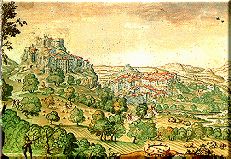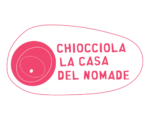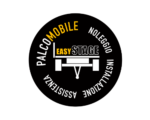 Two steep hills called “Rupe” (cliff) and “Roccione” (big rock), surrounded in the background by the woody tableland of the west-side of Carpegna-mountain, in the green area of the Sasso Simone Park, characterize the old town of Pennabilli, where, in the neighbourhood, as the many archaeological excavations demonstrate, Etruscan and Umbrian people settled. Romans took possession subsequently of the territory, The town and the Rupe cliffwhich had to suffer later the barbaric raids in the middle of the first millennium.
Two steep hills called “Rupe” (cliff) and “Roccione” (big rock), surrounded in the background by the woody tableland of the west-side of Carpegna-mountain, in the green area of the Sasso Simone Park, characterize the old town of Pennabilli, where, in the neighbourhood, as the many archaeological excavations demonstrate, Etruscan and Umbrian people settled. Romans took possession subsequently of the territory, The town and the Rupe cliffwhich had to suffer later the barbaric raids in the middle of the first millennium.
The rocky mountain-tops offered a refuge to the defenceless people of the region, who founded here Penna, which has an umbrian origin, and Billi, which has an etruscan origin.
The two  neighbour castles were rival until 1350, when they united with solemnity and laid the foundation-stone of the peace at the market-square on the slopes of the two cliffs (now Vittorio Emanuele II square). At first this Commune was a feud of the Carpegnas, and later of the Malatestas, and it was certainly their cradle, before this powerful family subjected all the Romagna. Frescoes in the Sanctuary of Virgin Mary of Grace. In fact, the Malatestas built, at the beginning of the 11th century, the fortress of Castel di Penna, of which only little ruins remain. In 1572, with the well-known Bull “Aequum reputamus”, Pope Gregorio XIII transferred the episcopal seat from San Leo to Pennabilli, because of security reasons: the town is still the cathedral of the Diocese of San Marino and Montefeltro.
neighbour castles were rival until 1350, when they united with solemnity and laid the foundation-stone of the peace at the market-square on the slopes of the two cliffs (now Vittorio Emanuele II square). At first this Commune was a feud of the Carpegnas, and later of the Malatestas, and it was certainly their cradle, before this powerful family subjected all the Romagna. Frescoes in the Sanctuary of Virgin Mary of Grace. In fact, the Malatestas built, at the beginning of the 11th century, the fortress of Castel di Penna, of which only little ruins remain. In 1572, with the well-known Bull “Aequum reputamus”, Pope Gregorio XIII transferred the episcopal seat from San Leo to Pennabilli, because of security reasons: the town is still the cathedral of the Diocese of San Marino and Montefeltro.
Many evidences of this important past are represented by valuable architectural works, as manifest signs of the original town-plan, which can be distinguished still today. In the castle of Penna, as well as the Gates, there are: the Palace of Bargello (ancient prison), the hamlet of St. Rocco (once hospital for pilgrims), the Sanctuary of Virgin Mary of Grace with the miraculous fresco (the Madonna image shed tears in 1489, according to the archive chronicles). The union of the two castles produced the development of the city in the Renaissance, all around the Fountain of PeaceMonastery of nuns of St. Agostino, with the “Palazzo della Ragione” by the Medici-family and the Cathedral dating back to the 16th century. The church was restored several times: the “red façade” was built at the beginning of the 20th century; the interior was renewed in 2000. This architectural whole is dominated by the monastery of nuns of St. Austin, erected in the 16th century on the precipice of the cliff, where are still on the top the remains of the castle of Billi. A big cultural interest has as well the Diocesan Museum National antiques exhibition in july (at the moment closed for restoration), with an historical and artistic patrimony collected all around in the Montefeltro region.
 Pennabilli can offer to visitors, as well as historical evidences, a National Antiques Exhibition and Market (which takes place every year in july since 1970) and the International Performing Arts Festival – Artisti in Piazza (in june since 1997). Visitors can as well see the innumerables spots created by the imagination of the poet Tonino Guerra, like the Sanctuary of Thoughts (a garden for meditation), the “Sundials” International street performers festival in june(colourful “time paintings” on the buildings of the old town) and the Garden of the forgotten fruits (with artistic installations among many unusual fruit-trees from the woods that nobody grows anymore). In the same garden, you can see as well the “Mulberry-tree of Peace”, planted by His Holiness the 14th Dalai Lama Tenzin Gyatso in 1994 June 15th, as a souvenir of his visit in Pennabilli.
Pennabilli can offer to visitors, as well as historical evidences, a National Antiques Exhibition and Market (which takes place every year in july since 1970) and the International Performing Arts Festival – Artisti in Piazza (in june since 1997). Visitors can as well see the innumerables spots created by the imagination of the poet Tonino Guerra, like the Sanctuary of Thoughts (a garden for meditation), the “Sundials” International street performers festival in june(colourful “time paintings” on the buildings of the old town) and the Garden of the forgotten fruits (with artistic installations among many unusual fruit-trees from the woods that nobody grows anymore). In the same garden, you can see as well the “Mulberry-tree of Peace”, planted by His Holiness the 14th Dalai Lama Tenzin Gyatso in 1994 June 15th, as a souvenir of his visit in Pennabilli.

The near village of Ponte Messa is the seat of the first Italian Museum of History of Calculus and Informatics, which is very rich in technical and documentary materials and is a special destination for school-groups (it opens to visitors only on the 3rd sunday of every month: please check the official site). For lovers of Nature, the region can offer itineraries in the Sasso Simone Regional Natural Park and to the Andreuccio Lake near the village of Soanne.






































